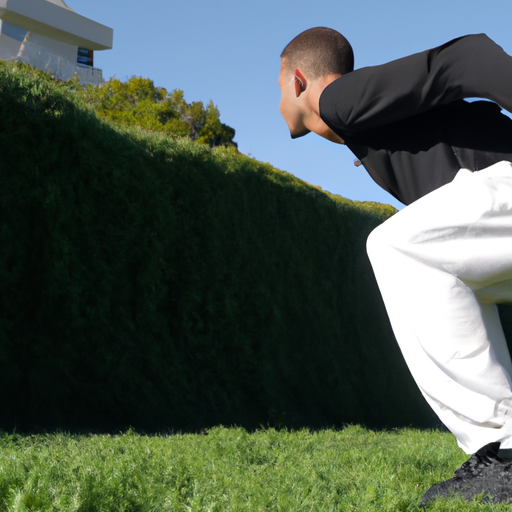
How to properly squat?
-
Contents
- 1 How to Properly Set Up for a Squat: A Step-by-Step Guide
- 2 The Benefits of Squatting: Why You Should Make Squatting Part of Your Workout Routine
- 3 Squatting with Proper Form: Tips for Avoiding Injury
- 4 Squat Variations: Exploring Different Types of Squats
- 5 Squatting for Different Fitness Levels: How to Adjust Your Squat for Maximum Results
- 6 Q&A
Table of Contents
- How to Properly Set Up for a Squat: A Step-by-Step Guide
- The Benefits of Squatting: Why You Should Make Squatting Part of Your Workout Routine
- Squatting with Proper Form: Tips for Avoiding Injury
- Squat Variations: Exploring Different Types of Squats
- Squatting for Different Fitness Levels: How to Adjust Your Squat for Maximum Results
- Q&A
Squatting is an essential exercise for building strength and improving overall fitness. It is a compound exercise that works multiple muscle groups at once, making it an efficient and effective way to build strength and power. Proper form is essential for getting the most out of your squats and avoiding injury. In this article, we will discuss the proper technique for performing a squat, as well as some tips for improving your form.
How to Properly Set Up for a Squat: A Step-by-Step Guide
Squats are an essential exercise for building strength and muscle in the lower body. When done correctly, they can help improve balance, coordination, and overall fitness. However, if done incorrectly, squats can lead to injury. To ensure you get the most out of your squats and stay safe, it is important to set up properly. Here is a step-by-step guide to help you do just that.
1. Start by standing with your feet slightly wider than shoulder-width apart. Point your toes slightly outward.
2. Bend your knees and lower your hips until your thighs are parallel to the floor. Make sure your back is straight and your chest is up.
3. Keep your weight on your heels and your core engaged.
4. Push your hips back and down as you lower yourself.
5. Keep your head up and your eyes looking forward.
6. Once you reach the bottom of the squat, pause for a moment and then drive through your heels to stand back up.
7. Repeat the movement for the desired number of repetitions.
By following these steps, you can ensure that you are setting up properly for a squat. Remember to keep your form in check throughout the entire movement and to listen to your body. If you experience any pain or discomfort, stop immediately and consult a medical professional.
The Benefits of Squatting: Why You Should Make Squatting Part of Your Workout Routine
Squatting is an essential exercise that should be included in any workout routine. This exercise is beneficial for a variety of reasons, including improved strength, balance, and flexibility. Additionally, squatting can help to reduce the risk of injury and improve overall health.
First and foremost, squatting is an excellent way to build strength. Squatting works the muscles in the legs, hips, and core, which are all important for overall strength and stability. Additionally, squatting can help to improve balance and coordination, as it requires the body to work together to maintain proper form. This can help to reduce the risk of falls and other injuries.
Squatting is also beneficial for flexibility. This exercise helps to stretch and strengthen the muscles in the lower body, which can help to improve range of motion and reduce the risk of injury. Additionally, squatting can help to improve posture, as it encourages the body to maintain a neutral spine position.
Finally, squatting can help to improve overall health. This exercise helps to increase blood flow to the muscles, which can help to reduce inflammation and improve circulation. Additionally, squatting can help to strengthen the bones and reduce the risk of osteoporosis.
In conclusion, squatting is an essential exercise that should be included in any workout routine. This exercise is beneficial for a variety of reasons, including improved strength, balance, and flexibility. Additionally, squatting can help to reduce the risk of injury and improve overall health. For these reasons, it is important to make squatting part of your regular workout routine.
Squatting with Proper Form: Tips for Avoiding Injury
Squatting is an important exercise for strengthening the muscles of the lower body, but it must be done with proper form to avoid injury. Here are some tips for squatting with proper form:
1. Start with your feet shoulder-width apart and your toes pointing slightly outward.
2. Keep your chest up and your back straight.
3. Bend your knees and lower your hips until your thighs are parallel to the floor.
4. Keep your weight on your heels and your knees in line with your toes.
5. Push through your heels to return to the starting position.
6. Avoid locking your knees at the top of the movement.
7. Make sure to keep your core engaged throughout the exercise.
By following these tips, you can ensure that you are squatting with proper form and avoiding injury. Squatting is an important exercise for strengthening the muscles of the lower body, so make sure to do it safely and correctly.
Squat Variations: Exploring Different Types of Squats
Squats are a fundamental exercise for building strength and muscle in the lower body. They are a compound exercise, meaning they involve multiple muscle groups, and can be performed with or without weights. Squats can be modified in a variety of ways to target different muscle groups and to increase the intensity of the exercise. In this article, we will explore some of the different types of squats and how they can be used to maximize your workout.
The traditional squat is the most basic type of squat. It involves standing with your feet shoulder-width apart and your toes pointed slightly outward. You then lower your body by bending your knees and hips until your thighs are parallel to the floor. To complete the exercise, you push back up to the starting position. This type of squat is great for building strength and muscle in the quads, glutes, and hamstrings.
The sumo squat is a variation of the traditional squat. It is performed with your feet wider than shoulder-width apart and your toes pointed outward. You then lower your body by bending your knees and hips until your thighs are parallel to the floor. This type of squat is great for targeting the inner thighs and glutes.
The Bulgarian split squat is another variation of the traditional squat. It is performed with one foot elevated on a bench or box behind you. You then lower your body by bending your front knee until your thigh is parallel to the floor. This type of squat is great for targeting the quads and glutes.
The jump squat is a more advanced variation of the traditional squat. It involves performing a traditional squat and then jumping explosively off the ground. This type of squat is great for building power and explosiveness in the lower body.
The pistol squat is a challenging variation of the traditional squat. It involves standing on one leg and then lowering your body by bending your knee until your thigh is parallel to the floor. This type of squat is great for building strength and balance in the lower body.
Squats can be modified in a variety of ways to target different muscle groups and to increase the intensity of the exercise. By exploring different types of squats, you can maximize your workout and achieve your fitness goals.
Squatting for Different Fitness Levels: How to Adjust Your Squat for Maximum Results
Squatting is an essential exercise for any fitness level, as it works multiple muscle groups and helps to build strength and stability. However, it is important to adjust your squat for maximum results based on your fitness level. Here are some tips on how to adjust your squat for different fitness levels.
Beginner: If you are a beginner, it is important to focus on form and technique. Start with a bodyweight squat, and make sure to keep your back straight and your chest up. Keep your feet shoulder-width apart and your toes pointed slightly outward. As you squat, keep your weight in your heels and drive your hips back. Make sure to keep your knees in line with your toes and avoid letting them cave in.
Intermediate: Once you have mastered the bodyweight squat, you can start to add weight. Start with a barbell squat, and make sure to keep your back straight and your chest up. Keep your feet shoulder-width apart and your toes pointed slightly outward. As you squat, keep your weight in your heels and drive your hips back. Make sure to keep your knees in line with your toes and avoid letting them cave in.
Advanced: For advanced fitness levels, you can add more weight and complexity to your squat. Try a front squat, where you hold the barbell in front of your chest. Make sure to keep your back straight and your chest up. Keep your feet shoulder-width apart and your toes pointed slightly outward. As you squat, keep your weight in your heels and drive your hips back. Make sure to keep your knees in line with your toes and avoid letting them cave in.
No matter your fitness level, it is important to adjust your squat for maximum results. By focusing on form and technique, you can ensure that you are getting the most out of your workout.
Q&A
1. What is the correct form for a squat?
The correct form for a squat is to stand with your feet slightly wider than shoulder-width apart, toes pointed slightly outward. Keep your chest up and your back straight, and lower your hips until your thighs are parallel to the floor. Push through your heels to return to the starting position.
2. What muscles are used when performing a squat?
The primary muscles used when performing a squat are the quadriceps, hamstrings, glutes, and core muscles.
3. What should I do if I feel pain in my knees when squatting?
If you feel pain in your knees when squatting, it is important to stop and assess the situation. Make sure you are using proper form and that your feet are in the correct position. If the pain persists, it is best to consult a doctor or physical therapist.
4. How often should I squat?
How often you should squat depends on your fitness goals and current level of fitness. Generally, it is recommended to perform squats two to three times per week.
5. What are some common mistakes to avoid when squatting?
Common mistakes to avoid when squatting include rounding your back, not keeping your chest up, not pushing through your heels, and not keeping your knees in line with your toes. Additionally, it is important to make sure you are using the correct weight for your level of fitness.Squatting is an essential exercise for overall health and fitness. It is important to learn how to properly squat in order to maximize the benefits and minimize the risk of injury. When squatting, it is important to keep your back straight, your chest up, and your feet shoulder-width apart. Additionally, it is important to keep your weight in your heels and to push your hips back as you lower your body. With practice and proper form, you can reap the many benefits of squatting.

